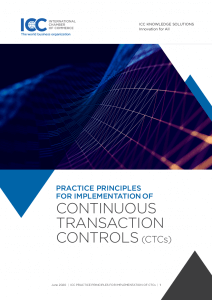ICC principles for continuous transaction controls: a model for optimizing the real-time economy?

Two years ago, the International Chamber of Commerce (ICC) put together a dialogue between practitioners and executives from businesses and tax administrations on the subject of continuous transaction controls (CTCs). From the beginning, the group of enterprise experts and advisors worked closely together with CTC pioneers from a number of countries, as well as key organizations such as CIAT.
What is this all about?
While CTCs are viewed as a logical step towards more modern methods to enforce tax laws, they introduce a completely different level of dependency between businesses and tax administrations.
If you send your university supervisor a report of your activities at the end of every month, the form and method of sending the report may be more or less convenient for you and the supervisor, but if it’s imperfect to one or both parties, this will at most lead to frustration – it will not impact your ability to move on with your research. If instead you agree to provide such information on a daily or even hourly basis, this is potentially much more useful for your supervisor to be able to intervene efficiently, but only on the condition that you are not hindered in your work and your supervisor receives the information in a way that allows real-time scrutiny.
Now imagine your supervisor wants not just to follow your progress in real time, but also to approve every step along the way, so you can only move on to a next phase in your research after she has approved each tiny incremental step towards finalization. This creates an unprecedented level of control for your supervisor, but also very high interdependency. Even the smallest communication problem can have significant consequences on your ability to meet deadlines.
This is more or less how CTCs work. CTCs come in many different shapes and forms – which is one of the big problems – but many tax administrations consider them to be the most useful if they can influence the progression or legal validity of business transactions that do not comply with tax requirements. This (near) real-time dependency creates perhaps the most acute and important need in history for businesses and tax administrations to agree on how their systems can interact to avoid negative economic outcomes. And, as often, tax is just pioneering this model – many other forms of law enforcement and public service will in the coming decades adopt similar real-time or near-real-time methods of communication with citizens and businesses.
Unnecessary exponential growth in complexity
One way of thinking about this is in terms having to coordinate enormous amounts of micro-interactions between two colossal ‘digital transformations’, each constantly evolving with different goals and governance, and each comprising wildly varying subsystems. As CTCs spread around the world, therefore, it should be obvious that we’re heading towards exponential growth in complexity which serves none of the actors in the equation.
The idea of (near) real-time integration between business and tax administration systems has the potential to resolve age-old challenges with consumption tax collection. No one benefits from the inefficiencies in the traditional VAT system that have needlessly persisted for decades. The basic mechanism of forcing businesses to report totals of their sales and purchase transactions periodically was a necessary evil in the pre-internet days, but it creates frustrating administration burdens for businesses while remaining an extremely blunt – and outrageously ineffective – instrument for governments to combat fraud. Governments and businesses alike have been hemorrhaging hundreds of billions of dollars due to a lack of automation between them – money that could have been used to create jobs, or to improve healthcare and education globally.
In principle, therefore, the automation of the interface between tax administrations and businesses could be the perfect policy instrument to increase tax collection without raising taxes and increase economic efficiency at the same time. A win-win policy instrument, therefore, of the kind that presents itself only very, very rarely.
Another – often underestimated – dimension of the same subject is that automation of the interface between TA and businesses also helps to automate interfaces among companies: the standardization brought by the adoption of a CTC system or an entire country encompasses the opportunity for the adoption of a single “language” that allows companies to interchange information about their commercial transactions between them. In many countries and sectors, such interoperability between business systems had not emerged from the operation of market forces alone.
A missed opportunity?
The introduction of e-invoicing and other CTC mechanisms has allowed significant gains for both tax administration and the majority of taxpayers that conduct their activities within a country’s borders. A common set of standards and processes driven by CTCs have in many instances allowed businesses to accelerate interopable automation processes and to reduce their compliance costs. Sadly, when we talk about international commerce or companies that conduct business in multiple jurisdictions we’re far from exploiting this unique opportunity. In this context, it is important to note that cross-border commerce is no longer the exclusive domain of larger or multinational companies – the Internet and e-commerce tools have opened up global markets even for micro-enterprises.
Viewed on an international level, however, the introduction of CTCs has seen little coordination among tax administrations, and even less with businesses. This means that businesses that act under the tax laws of multiple countries need to adjust their enterprise systems and core financial processes to integrate in real time with diverse detailed specifications for real-time data exchange. The continuous and diverse nature of these automated communications with tax administrations injects massive complexity into the delicate art of getting heterogeneous business systems to communicate with each other. In technical terms, we’re talking easily hundreds of thousands of permutations that need to be taken into account by software programs tying it all together. This complexity increases in the case of mergers and acquisitions that involve companies operating under different sets of rules.
This diversity increase security exposure, reduces resilience and can even introduce new economic inefficiencies – to a point that some have hypothesized that electronic invoicing based on these schemes for companies that are active in multiple countries could become just as expensive again as paper-based invoicing. Although that might be an exaggeration, we can recognize that the diversity is a far cry from ideal: no rational argument and no interest group stood in the way of creating an unprecedented win-win for all stakeholders, yet despite this virtuous perfect storm we’re somehow well on our way to messing it all up.
The same applies to the interchange of information between companies established in different countries: the domestic silo approach prevented CTCs from contributing to further harmonization of cross-border transactions.
The reason that things went this way is that stakeholders only talk inside individual country borders. This is a very understandable and logical consequence of political decision-making, of course, but the fact of the matter is there is not a single authority that could establish an invoice standard for transborder operations. It must be acknowledged that it is a very complicated task to bring all stakeholders outside individual country borders together to talk to each other about this particular issue.
The ICC CTC principles lead the way
 The ICC initiative was and is extremely important. The result of this dialogue is a set of basic principles that the public/private sector group has adopted unanimously. While their shock value if extremely low – these are all commonsense principles – their merit lies in the fact that they are the result of two years of active collaboration and deep analysis between public and private sector experts. Viewed from that angle, these principles are nothing short of revolutionary. If tax administrations and businesses globally continued to work together based on this example, taking into account the ICC principles, we would course-correct the transformation to a real-time economy and outcomes could be radically different from what the world would look like if we let the status quo play out.
The ICC initiative was and is extremely important. The result of this dialogue is a set of basic principles that the public/private sector group has adopted unanimously. While their shock value if extremely low – these are all commonsense principles – their merit lies in the fact that they are the result of two years of active collaboration and deep analysis between public and private sector experts. Viewed from that angle, these principles are nothing short of revolutionary. If tax administrations and businesses globally continued to work together based on this example, taking into account the ICC principles, we would course-correct the transformation to a real-time economy and outcomes could be radically different from what the world would look like if we let the status quo play out.
Organizations like ICC and CIAT are in the forefront advocating for a future where businesses and governments change their communication models in accordance with the huge economic and societal stakes, the completely new demands of the real-time economy and the fast pace change we observe in technology and business models. The old model is certain to produce not just sub-optimum outcomes but massive economic waste. Now that we have demonstrated that there’s a realistic alternative with very promising results, there’ll be no excuses if nonetheless we keep working along old public-private sector communication paradigms where parties look at each other with caution, if not distrust, instead of a cooperative approach that would realize potential of the real-time economy for all stakeholders.
ICC Continuous Transaction Control (CTCs) Practice Principles
4,349 total views, 1 views today
